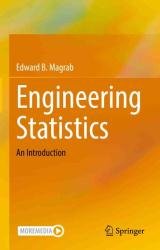Engineering Statistics: An Introduction
- Добавил: literator
- Дата: 16-10-2022, 16:26
- Комментариев: 0
 Название: Engineering Statistics: An Introduction
Название: Engineering Statistics: An IntroductionАвтор: Edward B. Magrab
Издательство: Springer
Год: 2022
Страниц: 176
Язык: английский
Формат: pdf
Размер: 10.04 MB
This book presents a concise and focused introduction to engineering statistics, emphasizing topics and concepts that a practicing engineer is mostly likely to use: the display of data, confidence intervals, hypothesis testing, fitting straight lines to data, and designing experiments to find the impact of process changes on a system or its output. It introduces the language of statistics, derives equations with sufficient detail so that there is no mystery as to how they came about, makes extensive use of tables to collect and summarize important formulas and concepts, and utilizes enhanced graphics that are packed with visual information to illustrate the meaning of the equations and their usage. The book can be used as an introduction to the subject, to refresh one’s knowledge of engineering statistics, to complement course materials, as a study guide, and to provide a resource in laboratories where data acquisition and analysis are performed.
The book recognizes that there are many computational tools available to perform the statistical analysis of data, and, therefore, the numerical details in the more computationally intensive examples are omitted. However, to facilitate all numerical calculations used in the book and to permit one to further explore the material, a set of interactive graphics (IGs) has been created using Mathematica. The IGs are designed to do specific tasks in the context of the material. The IGs can be used to expand many of the figures by changing the figure’s parameters, to evaluate relations in tables, to verify examples, and to solve exercises. One IG determines values for the probability and inverse probability of the normal, t, chi square, and f distributions. They do not require any programming, and their use is self-explanatory in the context of the material. The IGs are on the publisher’s website as are their description and how to acquire the free software to run them.
The book consists of four chapters. In each chapter, there are numerical examples to illustrate the application of the results and exercises at the end of the chapter.
Скачать Engineering Statistics: An Introduction
Внимание
Уважаемый посетитель, Вы зашли на сайт как незарегистрированный пользователь.
Мы рекомендуем Вам зарегистрироваться либо войти на сайт под своим именем.
Уважаемый посетитель, Вы зашли на сайт как незарегистрированный пользователь.
Мы рекомендуем Вам зарегистрироваться либо войти на сайт под своим именем.
Информация
Посетители, находящиеся в группе Гости, не могут оставлять комментарии к данной публикации.
Посетители, находящиеся в группе Гости, не могут оставлять комментарии к данной публикации.
